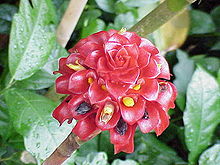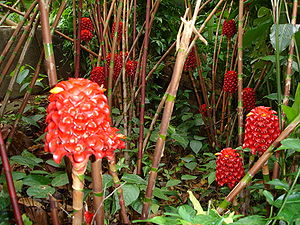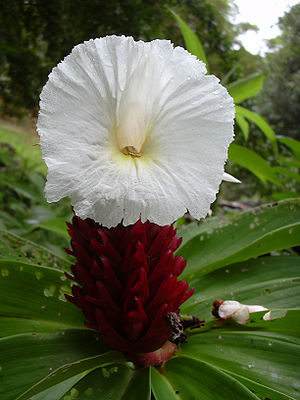- Costaceae
-
Costaceae 
Tapeinochilos ananassae of the family Costaceae Scientific classification Kingdom: Plantae (unranked): Angiosperms (unranked): Monocots (unranked): Commelinids Order: Zingiberales Family: Costaceae Genera - Monocostus
- Dimerocostus
- Chamaecostus
- Costus
- Paracostus
- Cheilocostus
- Tapeinochilos
Costaceae or the Costus Family is a family of pantropical monocots. They belong to the order Zingiberales, which contains other horticulturally and economically important plants such as the banana (Musaceae), bird-of-paradise (Strelitziaceae), and edible ginger (Zingiberaceae). The seven genera contain about 100 species (1 in Monocostus, 2 in Dimerocostus, 16 in Tapeinochilos, 2 in Paracostus, ca. 8 in Chamaecostus, ca. 4 in Cheilocostus, ca. 80 in Costus) and are found in tropical climates of Asia, Africa, and Central/South America.
Costaceae are unique from other members of Zingiberales in that its species have 5 fused staminodes, rather than 2, and Costaceae contain no aromatic oils. The fused infertile stamen form a large petalloid labellum that often functions to attract pollinators. The flowers are generally solitary or aggregated in inflorescences. Inflorescences are arranged in a terminal head or spike, except for Monocostus. The simple leaves are entire and spirally arranged, with those toward base of the stem usually bladeless. Leaf bases have a closed sheath with a ligule, or projection at the top of the sheath. Fruit is a berry or capsule. The rhizome is fleshy with tuberous roots.
See also
- Spiral Ginger, Costus barbatus
References
- The Families of Flowering Plants by L. Watson and M. J. Dallwitz.
- Family Costaceae
- Specht, Chelsea D. & Stevenson, Dennis Wm. 2006. A new phylogeny-based generic classification of Costaceae (Zingiberales).Taxon 55(1):153-163.
Categories:- Costaceae
- Commelinid families
Wikimedia Foundation. 2010.


